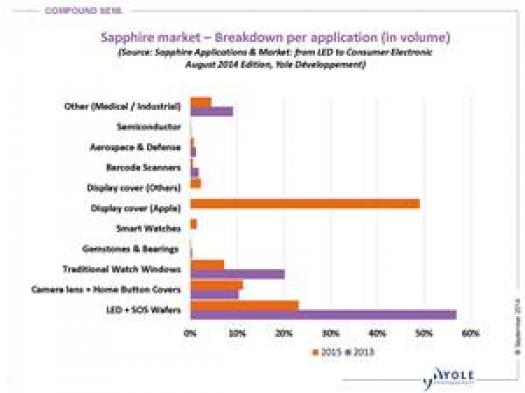Sapphire supply chain issues behind iPhone 6 change?

The long wait is finally over. From a sapphire industry standpoint, Apple killed the suspense within the first 10 minutes by announcing that its new 4.7" and 5.5" iPhone 6 and iPhone 6 plus will both feature a traditional ion-exchange strengthened glass display cover. Sapphire remains in the camera lens cover and the touch ID sensor, features that were already present on the iPhone5s.
Yole Développement believe that technical and manufacturing issues at various levels of the supply chain have prevented Apple from using sapphire as the display cover in this year iteration of its iPhone. An important feature of the design of the new iPhone is that the case doesn't wrap around the display cover. To protect the edges and, more specifically the corners, the part features a complex shape with smooth curves. This design resulted in fairly low finishing yields with sapphire which drove the cost to above $40 per part.
Apple focused the show on the long anticipated smart watch, announced in three customizable versions named "Apple Watch", "Apple Watch Sport" and "Apple Watch Edition". Both the "Watch" and "Edition" versions feature a sapphire display cover on the front. On the back, a zirconia ceramic cover with four sapphire lenses protects a heart rate sensor. The "Sport" model however relies on strengthened ion-exchange glass for the display cover and the lenses. The watches come in 2 case sizes of 38 and 42 mm. The sapphire display cover is a 2.5D design with a surface curved toward the edges that blends in smoothly with the watch case.
"We estimate that for the largest model, those covers are manufactured from long sapphire bars of 40 x 34 mm cross section sliced at a pitch of about 1.8 mm", details Dr Eric Virey, Senior Analyst at Yole Développement."The 4 lenses on the back appear to have dimensions fairly similar to the one featured on the iPhone camera lens cover", he adds.
The watches however won't be available until "early 2015".
This raises the question of the status of GTAT mega-sapphire plant in Mesa, Arizona. The company might have to wait another year for an opportunity of a design win in the next iPhone. On a positive side, the company and the downstream supply chain might use this additional time to debottleneck their process and possibly take the "Hyperion" lamination technology from advanced R&D to a manufacturing-ready level that could bring a real disruption in the way to use sapphire in displays.
But for now, smart watches won't provide enough upside to hit initial revenue targets. Apple currently sources sapphire for this product from multiple suppliers, most located in China. "Even if GTAT was supplying a significant fraction of Apple smart watches, we estimate that total revenue derived from this opportunity wouldn't exceed $45m in 2014, far from the company's initial revenue guidance for its sapphire business", says Eric Virey. "If Apple wants to help GTAT, it could also shift more of its other sapphire needs away from its current suppliers. Under those circumstances, it will also be interesting to see if GTAT revises guidance for 2014 and if it receives the last US$139M installment of the $578M of prepayment promised by Apple before the end of the year. If so, this would show that Apple still supports GTAT and the overall project. GTAT was initially expected to start paying back this sum over quarterly installments starting in 2015 and we'll also see if Apple tries to enforce this", he comments.
Apple has nevertheless generated a lot of excitement in the sapphire industry since the announcement of its partnership with GTAT. It remains to be seen if, after adopting sapphire for the camera lens cover in 2012 and in the home button in 2013, the Apple Watch announcement is the last stop or just another step of the journey. Various OEMs have recently introduced smartphones featuring sapphire display covers.
Kyocera introduced its sapphire Brigadier to the US Market in August and on September 4th, Huawei announced its "P7 Sapphire edition".
Xiaomi, a fast growing Apple competitor on the Chinese market also plans a limited edition featuring sapphire.
To the exception of Kyocera's Brigadier which specifically targets the market of rugged smartphone, most of those announcements were intended at testing the market and showing capabilities ahead of a possible Apple announcement. None will come anywhere close to the iPhone in term of volume potential.
This announcement event might therefore signal the death of sapphire as a display cover in smartphones. But after the tremendous buzz generated by the Apple and GTAT partnership, and following the positive reviews received by the first sapphire smartphones, the lack of a "sapphire iPhone" announcement might instead create a vacuum that Apple competitors will be eager to fill before Apple potentially enters the market.
"In any case, 2015 will be a pivotal year: the idea of using the material for smartphones display covers will either materialize in multiple devices and transform the industry, or just crash and burn", concludes Eric Virey, from Yole Développement.
Yole Développement updated last August its Sapphire Applications & Market report. For more information about this technology & market analysis, please visit www.i-micronew.com, compound semi. section.

































